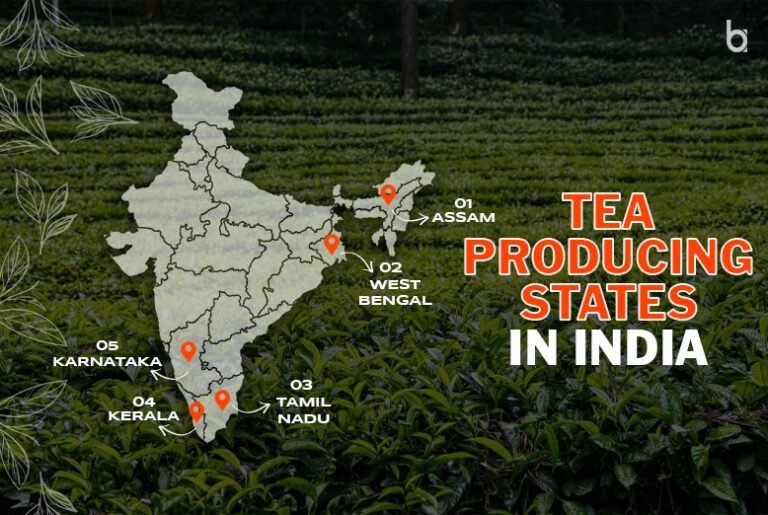Ever pause while sipping your morning chai and wonder where that magic comes from? That gentle steam carries stories of mist-covered mountains, sun-drenched plains, and generations of tradition. In India, tea isn’t just a drink; it’s the nation’s heartbeat, a cherished ritual that connects millions. From the powerful, bold brews of Assam to the whisper-light, floral notes of Darjeeling, the variety is simply mind-blowing.
So, where does all this magic come from? You’re about to find out. We’re diving deep into the heartlands of Indian chai with our official, data-packed 2025 ranking of the top tea producing states in India. Get ready for a journey that will tantalize your senses and leave you with a newfound appreciation for every single leaf in your cup. Let’s go!
Firstly, Let’s Understand the Foundation of Indian Tea
1. Why Tea Thrives Here: The Perfect ‘Terroir’
Ever wondered why a Darjeeling tea tastes nothing like an Assam tea? The secret is a beautiful French word: terroir. Think of it as a place’s unique signature. It’s the magical combination of:
- Topography: The hills, valleys, rivers, and altitude.
- Climate: The specific dance of sun, rain, and seasons.
- Soil: The minerals and nutrients hidden in the earth.
- Environment: The other plants growing nearby.
In India, this combination is just perfect. For example, the long, chilly winters in Darjeeling actually stress the tea plants, forcing them to create an explosion of complex flavours and aromas. It’s incredible, right? Meanwhile, Assam’s hot, humid, tropical vibe is what gives its tea that classic, strong malty punch we all love. It’s nature’s own recipe!
2. From Bud to Brew: The Journey of a Tea Leaf
A tea leaf’s life is a fascinating adventure before it ever reaches your cup. It’s a delicate art!
First comes the Plucking. Skilled hands carefully pick only the youngest, most tender buds and leaves. Timing is everything here.
Then, we have the Flushes, which are the different harvest seasons. Each one tells a different story:
- First Flush (Late Feb – Mid-Apr): These are the superstars! Made from nutrients the plant stored all winter, they’re delicate, floral, and oh-so-premium.
- Second Flush (May – Jun): Here’s where it gets wild. Tiny green flies called Jassids bite the leaves, and in response, the plant releases a substance called turpene. The result? A mind-blowing honey and muscatel flavour. Nature is amazing!
- Monsoonal Flush (Jul – Sep): The heavy rains create leaves with a milder flavour, perfect for blending.
- Autumnal Flush (Oct – Nov): As things cool down, the leaves pack in rich notes of fruit and berries. Simply delicious.
After plucking, the leaves go through Withering (drying), Rolling (to release enzymes), Oxidation (where the flavour develops), Drying (to lock it all in), and finally Sorting. From there, they head to auctions and eventually, to your home. What a journey!
3. The Spectrum of Indian Tea
India is a master of all tea types:
- Black Tea: The most popular. It comes in two main styles: Orthodox (traditional, whole-leaf, high-quality) and CTC (Crush, Tear, Curl – small pellets for strong, quick brews, perfect for chai).
- Green Tea: Fresh, vibrant, and minimally processed.
- Oolong Tea: Sits beautifully between green and black tea in flavour.
- White Tea: The most delicate of all, made from young buds.
India’s Top 10 Tea Producing States: 2025 Ranking
1. Assam
- Annual Production (Recent Est.): A jaw-dropping ~650 Million Kgs!
- Key Tea Varieties: The world-famous Assam CTC and Orthodox. It even has a GI tag for its Orthodox tea!
- Flavor Profile: Bold, malty, and wonderfully brisk with a sweet-spicy kick and a beautiful coppery color.
- Peak Harvest Seasons: March–June (for the first and second flushes) & October–November (autumn).
What Makes Assam So Special?
Assam is, without a doubt, the king. It’s the largest single tea-growing region on the planet! This is the native home of the Camellia sinensis var. assamica plant, which gives us those rich, powerful teas that define breakfast blends worldwide. The unique humidity from the river plains supercharges that signature malty flavor. With a history stretching back to 1837, Assam isn’t just a state; it’s a living legend.
Economically, it’s a powerhouse, employing over a million people and exporting more than 80 million kgs to countries like Russia, the UK, and the UAE. Its Guwahati Tea Auction Center is one of the busiest in the world. Visiting Assam feels like plugging directly into the heart of Indian tea.
2. West Bengal
- Annual Production (Recent Est.): ~336 Million Kgs
- Key Tea Varieties: Darjeeling’s famous black, green, white, and oolong teas, plus robust CTC from the Dooars and Terai regions. The GI-tagged Darjeeling Tea is iconic.
- Flavor Profile: Think elegant! Floral, with that legendary muscatel (grape-like) note, hints of citrus, and graceful tannins.
- Peak Harvest Seasons: March–May (spring), June–July (second flush), followed by a winter slumber.
What Makes West Bengal Shine?
Home to Darjeeling, the “Champagne of Teas,” this state is all about elegance. Grown on misty slopes reaching 2,000 meters, the 84 GI-tagged estates produce tea with an almost mythical flavor. Believe it or not, that famous muscatel note is thanks to a tiny local leafhopper interacting with the tea leaves! How cool is that?
Down in the plains, the Dooars and Terai regions produce fantastic, brisk CTC teas. West Bengal is India’s second-largest tea employer and a massive exporter, sending over 60 million kgs (with Darjeeling alone contributing around 9 million) to Japan, Germany, and the USA. Experiencing a tea tasting here, with the Himalayas in the background, is simply unforgettable.
#3. Tamil Nadu
- Annual Production (Recent Est.): ~163 Million Kgs
- Key Tea Varieties: The beautifully fragrant Nilgiri Orthodox, green, and black teas. Yes, it has a GI tag too!
- Flavor Profile: Wonderfully aromatic and fragrant, brisk, with sweet and citrusy notes.
- Peak Harvest Seasons: December–March is peak season, with a secondary flush from June–August.
What’s the Nilgiri Secret?
The Nilgiris, or “Blue Mountains,” are truly special. These high-grown teas have a rare combination of sweetness and fragrance that makes them a favorite in luxury blends across the globe. The cool, misty mountain air and the daily temperature shifts give the teas their signature enchanting aroma.
The state’s tea industry supports over 100,000 workers and is a major exporter to the UK, Russia, and the Middle East. With bustling auction centers in Coonoor and Coimbatore, Tamil Nadu is a southern powerhouse with a wonderfully delicate touch.
4. Kerala
- Annual Production (Recent Est.): ~60 Million Kgs
- Key Tea Varieties: Smooth Munnar Orthodox and green teas.
- Flavor Profile: Incredibly smooth, sweet, grassy, with delicate floral hints.
- Peak Harvest Seasons: April–June (summer) & September–November (autumn).
What Makes Kerala So Breathtaking?
Kerala’s mountain microclimates are perfect for growing fine-leaf teas with beautifully delicate flavors. The panoramic gardens of Munnar are famous for their orthodox and organic teas. It’s a place where tradition meets innovation, as they are always experimenting with new cultivars. Though smaller in production, its impact on quality is huge. A visit to the tea gardens in Munnar or Wayanad, with their rolling green hills, is pure therapy.
5. Karnataka
- Annual Production (Recent Est.): ~5 Million Kgs
- Key Tea Varieties: Orthodox, green, and unique wild teas.
- Flavor Profile: Light, fresh, with nuanced vegetal and floral tones.
- Peak Harvest Seasons: May–September (the monsoon flush).
What’s Brewing in Karnataka?
Tucked away near the Western Ghats, Karnataka’s tea estates are like biodiversity reserves. They are home to rare cultivars and are leaders in organic cultivation. While it’s a smaller player, it focuses on the premium niche market, supplying hundreds of small farmers and exporters. A tea trip through Chikmagalur and Coorg is an adventure that blends eco-tourism with amazing wildlife trails.
#6. Arunachal Pradesh
- Annual Production (Recent Est.): ~11-12 Million Kgs
- Key Tea Varieties: Orthodox, green, and exciting wild teas.
- Flavor Profile: Subtle and grassy with a brisk, high-grown freshness.
- Peak Harvest Seasons: May–September.
The Excitement of Arunachal!
This state is the new frontier! The Eastern Himalayas are nurturing a new wave of cold-climate teas that are celebrated for their vibrant, fresh flavors and wild potential. Its estates are expanding fast, creating new jobs and exporting to specialty buyers who are falling in love with these unique brews. Here, tea gardens blend seamlessly with lush forests and rich tribal heritage.
7. Tripura
- Annual Production (Recent Est.): ~7.5 lakh Kgs
- Key Tea Varieties: CTC, green, and organic teas.
- Flavor Profile: Smooth, earthy, and pleasantly brisk.
- Peak Harvest Seasons: March–June.
Tripura’s Gentle Charm
With its hilly terrain and a strong push for organic farming, Tripura delivers teas with a clean and gentle profile. It’s building a strong network of small farmers whose teas are finding their way to Eastern Asian markets. A visit here is a cultural delight, filled with folk festivals and artisanal community teas.
My Opinion
Looking at the numbers, the Indian tea industry is on an impressive path. Valued at USD 11.72 billion in 2024, it’s set to climb to USD 15.12 billion by 2030, growing at a solid 4.34% CAGR. What does this tell us? It shows an industry that’s mastering the balance between affordable, everyday CTC tea and the growing global hunger for high-quality specialty and organic brews.
The future for the tea producing states in India is bright, driven by innovation, a deep understanding of consumer health trends, and an unwavering commitment to quality. India’s place on the world tea stage isn’t just secure; it’s set to become even more influential.
Here Are Some Secrets of Indian Tea
- The Muscatel Magic Trick:
That world-famous muscatel flavor in Darjeeling tea? It’s created when a specific local leafhopper (Empoasca flavescens) nibbles on the tea leaves, causing a defensive reaction that produces unique aromatic compounds. It’s a beautiful accident of nature!
- India’s Wild Tea Heritage:
Did you know Assam is one of only two places in the entire world (the other being Southern China) where tea plants grow wild? This makes it an incredibly important genetic resource for tea breeders everywhere.
- Kangra’s Lost & Found Art:
The tea makers in Himachal’s Kangra Valley once used a traditional Chinese pan-firing method. This art was lost after the devastating Kangra earthquake of 1905, but was later revived through incredible local innovation. Talk about resilience!
- The Auction Powerhouses:
India’s tea auction centers in Siliguri and Guwahati are global pioneers. They set the standard for transparent, real-time pricing that has become a model for commodity markets around the world.
- Bio-Engineering Marvels:
Indian tea research institutes are unsung heroes! They have developed amazing drought-resistant Camellia clones that are now used to grow tea across Africa and Southeast Asia.
Share the Story!
The story of Indian tea is written in every rolling hill and savored in every single cup. If this journey through India’s tea heartlands has warmed your soul, why not share it with your friends and fellow tea lovers? Let’s spread the word about this incredible legacy together!



